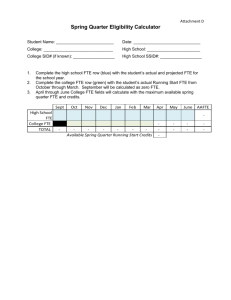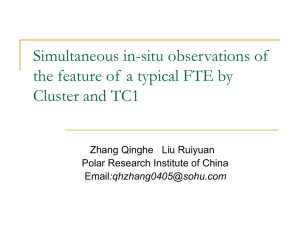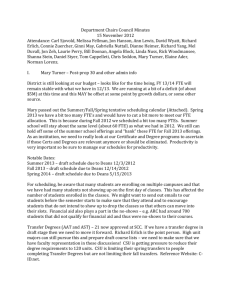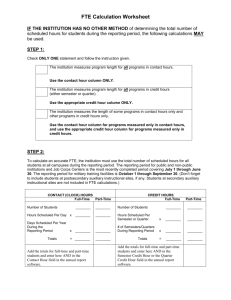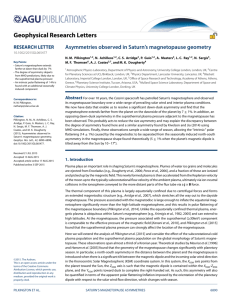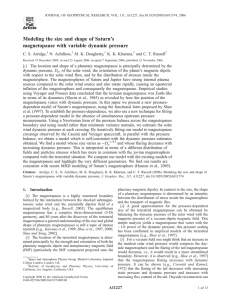Liu_Jiang_FTE_VA_20070121
advertisement
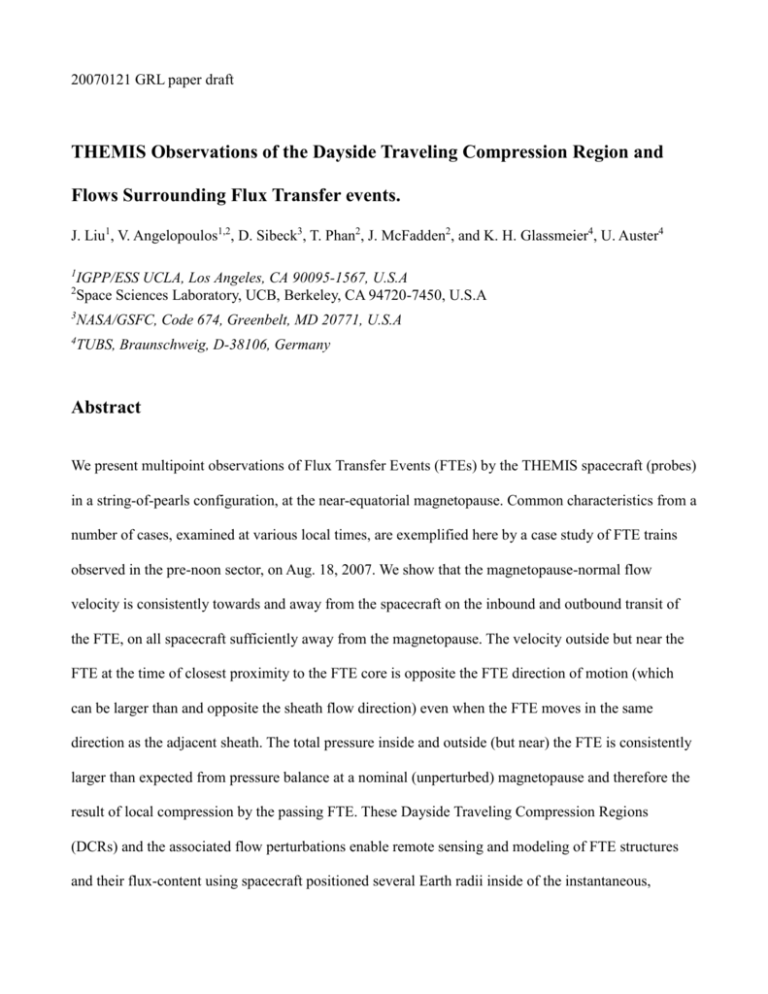
20070121 GRL paper draft THEMIS Observations of the Dayside Traveling Compression Region and Flows Surrounding Flux Transfer events. J. Liu1, V. Angelopoulos1,2, D. Sibeck3, T. Phan2, J. McFadden2, and K. H. Glassmeier4, U. Auster4 1 2 IGPP/ESS UCLA, Los Angeles, CA 90095-1567, U.S.A Space Sciences Laboratory, UCB, Berkeley, CA 94720-7450, U.S.A 3 NASA/GSFC, Code 674, Greenbelt, MD 20771, U.S.A 4 TUBS, Braunschweig, D-38106, Germany Abstract We present multipoint observations of Flux Transfer Events (FTEs) by the THEMIS spacecraft (probes) in a string-of-pearls configuration, at the near-equatorial magnetopause. Common characteristics from a number of cases, examined at various local times, are exemplified here by a case study of FTE trains observed in the pre-noon sector, on Aug. 18, 2007. We show that the magnetopause-normal flow velocity is consistently towards and away from the spacecraft on the inbound and outbound transit of the FTE, on all spacecraft sufficiently away from the magnetopause. The velocity outside but near the FTE at the time of closest proximity to the FTE core is opposite the FTE direction of motion (which can be larger than and opposite the sheath flow direction) even when the FTE moves in the same direction as the adjacent sheath. The total pressure inside and outside (but near) the FTE is consistently larger than expected from pressure balance at a nominal (unperturbed) magnetopause and therefore the result of local compression by the passing FTE. These Dayside Traveling Compression Regions (DCRs) and the associated flow perturbations enable remote sensing and modeling of FTE structures and their flux-content using spacecraft positioned several Earth radii inside of the instantaneous, nominal magnetopause. The semi-periodic compressional velocity oscillations on TH-A were observed under southward IMF conditions and are likely driven by nearby occurrences of FTE trains, implying recurrent reconnection with a similar periodicity. 1. Introduction Flux Transfer Events (Russell and Elphic, 1978) are thought to carry substantial amounts of flux from dayside reconnection to the magnetotail. They occur fairly frequently (Rijnbeck et al., 1984) at the magnetopause and are expected as a result of transient reconnection there (Scholer, 1988, Southwood et al., 1988). While there exists evidence for both continuous reconnection (Phan et al., 2006) and pulsed reconnection (Lockwood and Smith, 1992), their relative importance for energy transfer at the magnetopause is not known. FTEs may also participate in energy transfer across the magnetopause by generating boundary layer waves which couple to the inner magnetosphere as field line resonances (Glassmeier et al., 1984), especially given their recurrence rate of 2-5 minutes, which in the Pc5 frequency band (Kuo et al., 1995). The relative importance of FTEs to other drivers of global magnetospheric oscillatons, such as solar wind dynamic pressure changes (Sibeck, 1989), the KelvinHelmholz instability (Pu and Kivelson, 1983), or time varying reconnection is still unknown. Much of the difficulty in answering such questions is purely observational. With single or multiple but few spacecraft at disparate locations, it is at best difficult to observe simultaneously nearby upstream solar wind variations and local magnetopause effects, and to clearly differentiate between boundary undulations (waves) and FTEs. Modeling of FTEs is quite helpful in interpreting data from nearby FTE crossings. Magnetic field modeling of the FTE proper has resulted in significant success in explaining the azimuthal component of the field within the FTE proper (Cowley, 1982; Saunders et al., 1984). The field and flow line draping expected around the FTE has been modeled by Farrugia et al., 1987. Sibeck and Smith (1992), suggested that the flow past the FTE can be opposed to the FTE motion, due to the displacement of the ambient magnetospheric plasma by the FTE itself. This flow signature is important to understand and differentiate from reconnection flows at the magnetopause on either side of an FTE. Pressure changes within an FTE are observed and can be explained as due to the development of strong core magnetic fields arising from field aligned currents flowing along the twisted field lines of the rope (Kivelson and Khurana, 1995). Outside the FTE, however, compressional variations of the field are also expected due to the local pressure balance at the magnetopause, as affected by the passage of the FTE. This local quasi-static pressure balance leads to a modification of the magnetopause ChapmanFerraro currents in the vicinity of the FTE. The signature of those local pressure balance currents ought to extend to the neighborhood of the FTE itself, just as the signatures of tailward moving plasmoid/flux rope extend in the magnetotail lobes, creating traveling compression regions (Slaving et al., 1988?). In this paper we present observations of Dayside Traveling Compression Regions (DTCRs) and flow variations associated with them, which are interpreted as signatures of nearby FTEs. The combination of pressure and flow perturbations described leads to a remote signature of FTEs which enables statistical studies of FTEs and their importance for global magnetospheric coupling, even with single spacecraft several RE away from the magnetopause. 2. Datasets and methodology THEMIS, launched on February 17, 2007, consists of five identical satellites (probes) equipped with comprehensive particles and fields instrumentation (Angelopoulos, 2008). During the first 7 months of the mission the probes traversed the dusk and dayside magnetosphere in a string-of-pearls configuration in highly elliptical orbits with 14.7 RE apogee and 16o inclination, coasting en-route to deployment onto their final orbits for their baseline science (Sibeck and Angelopoulos, 2008). The leading and trailing probes along the same orbit were at separations on the order of 1 RE, while the inner three probes were at separations of 100s of km, an ideal configuration for detailed studies of FTEs. We use data from the Fluxgate Magnetometer (FGM) instrument (Auster et al., 2008) and the ElectroStatic Analyzer (ESA) instrument (McFadden et al., 2008) on the THEMIS probes. We also used observations from the WIND spacecraft, located in the solar wind, at the Earth-Sun Lagrange point. Magnetic Fields Investigation (MFI) magnetometer data (Lepping et al., XXXX) and Solar Wind Experiment (SWE) plasma measurements (Ogilvie et al., XXXX) from WIND were time-shifted to a fiducial point at the subsolar magnetopause, and were used to routinely reconstruct the LMN coordinates at the magnetopause using the Shue [Shue et al., 1998] magnetopause model. We surveyed the magnetopause crossings by all THEMIS spacecraft using an automated transformation of the field into LMN coordinates, and FTE detection using the criterion of a bipolar signature in BN. (LIU JIANG, PLEASE EXPLAIN IN 2 LINES WHAT THE CRITERION WAS). We identified 100? EVENTS, which we then examined and down-selected to 9 events that obeyed the following loosely criteria: (i) THEMIS was in “fast mode” data collection operations; (ii) a bipolar BN event event was caught with at least one probes at the magnetopause boundary layer; and (iii) fast flows different from the observed or anticipated magnetosheath flow, were seen on at least one satellite. The latter criterion was intended for preferential selection of “active” FTE events, i.e., ones likely driven by reconnection on one or both sides. We examined the commonality of the flow and pressure perturbation signatures surrounding them to ascertain that the results presented by means of this event are consistent with the observations on the others. This paper is not a systematic, statistical study of such signatures, but the reader should know that our results are supported by observations during more than a handful of “active” FTE crossings. The event presented, occured on June 18th, 2007 between 0950 and 1030 UT. The probes were in an out-bound orbit, near the nominal model magnetopause (Figure 1). TH-B was leading and was furthest away from Earth, TH-A trailing and was the closest to Earth, while TH-C, -D and –E (shown in the insert in Figure 1) were in between the other two, in that order of decreasing distance. The probes were located about 2.5-3 RE south of the GSE equator and XRE south of the magnetic equator (JIANG LIU: PLOT USING TIPSOD IN SM COORDINATES AND TYPE HERE THE DISTANCE IN SM Z DIRECTION), at around 1010MLT. X E D C 1000km A B Y Fig. 1 The position of the THEMIS probes at 1010t, August 18th 2007, and the nominal magnetopause location for a solar wind dynamic pressure Pdyn=2.05nPa, shown in GSE coordinates. The probes were moving away from Earth (outbound leg). The orbit inclination is 16o. (JIANG LIU: PLEASE CLEAN UP THE PLOT: NEEDS B IN RED COLOR, AND PERHAPS FOUR LINES TO MARK THAT THE BOX IS AN INSERT) 3. Observations Several quantities from all five probes are shown in Figure 2, in a five probes per panel format. Red/Greeb/Ciel/Blue/Magenta correspond to probes TH-B/C/D/E/A. Data shown are the density, the magnetic field (LMN coordinates) and the total pressure. Additionally data from all five probes are also shown in one panel per probe format in Figure 3. There we show two panels per spacecraft: the ion spectrogram and the flow velocity (LMN coordinates). The probe data are arranged from the furthest out at the top (TH-B) to the closest in at the bottom (TH-B). magnetopause [Russell and Elphic , 1978], with N direction normal to the magnetopause pointing to magnetosheath, L direction along the projection of the Earth dipole axis onto the magnetopause (positive northward), and M directed dawnward. To get the local LMN coordinate, we used the Shue model of magnetopause [Shue et al., 1998], which is proved to be one of the magnetopause models with smallest errors [Suvorova et al., 1999]. In this model, the location of magnetopause is expressed by the eqation considering solar wind conditions: (the equation) where (equation). Here Bz is the IMF z component in nT in GSM coordinates, Pdyn is the solar wind dynamic pressure in nPa, and theta is the angle between the EarthSun line and magnetopause location vector, r. To apply this model to observations not made exactly at the magnetosphere, we use the stretched Shue model [Wang et al., 2005], which stretch the shape of the magnetopause to the position of the satellite: (equation) where (r', theta') is the position of the satellite in the same coordinate as (r, theta). With this analytical model we can simply get the N direction of the LMN coordinate by solving the magnetopause equation for normal direction. And then we can get the M direction by M=N cross Z, where Z is the GSM Z direction. As evidenced by the density (Fig. 2) and ion spectrogram (Fig. 3) of TH-B, that probe was in the magnetosphere at the beginning of the interval (density ~ 0.8/cc, 10keV peak energy), but by the end of the interval, at 1029 UT, had traversed into the high-density, lower-energy magnetosheath plasma (low density, 10keV peak energy). Temporary transitions into the magnetopause boundary layer, a mixture of magnetospheric and magnetosheath plasma, occurred six times between 1002 and 1023 UT, namely at ~ 1003, 1006, 1008:30, 1011, 1014:30 and 1020 UT. A more permanent transition into the layer occurred at 1029UT, at which point TH-B exited into the magnetosheath proper as evidenced by the reduction in the flux of 10keV energy particles at that time. The magnetic field on TH-B (next 3 panels on Fig. 2) shows a series of bipolar signatures on BN, accompanied by correlated bipolar or more complex signatures on BM. BL, near the direction of the internal field, also shows increases for some of these events, while the total field (not shown) shows temporary maxima for all of them. The above signatures are characteristic of flux transfer events and are interpreted as such in this paper. The vertical bars in the figure indicate times of FTEs on TH-B (LIU JIANG CAN YOU MARK ALL FTES BASED ON TH-B?). The FTEs were encountered from the magnetospheric side of the current layers prior to 1023UT and from the magnetosheath side after 1023UT. The flow direction within the FTEs (Fig. 3, second panel) is predominantly dawnward (with a few exceptions of north-south excursions). VM is comparable to (but at times stronger than) the sheath flow, which is seen to be ~100km/s at this end of the interval. The total pressure (including thermal and ram pressure normal to the nominal magnetopause) is shown at the bottom panel of Fig. 2. It indicates peaks that exceed the average pressure profile which starts at 0.9nPa at the beginning of the interval and ends at 0.8nPa at the end of the interval. These transient pressure increases indicate local pressure changes within the FTEs. We used the Tsyganenko 2001 model (T01) to predict the dynamic pressure (LIU JIANG CAN YOU PLEASE DO THIS?) within the magnetosphere at the time, using instantaneous solar wind measurements. Matching the WIND data with the field signatures at the sheath after the event, we found that the time lag between WIND and THEMIS is ~43 minutes (JIANG PLEASE CORRECT) and applied that to the data. We also adjusted the solar wind dynamic pressure to ensure a magnetopause crossing on TH-C at 10:29UT in the model. This ensures that the magnetopause currents from the model affect TH-C. The T01 model magnetic pressure at the location of TH-B is shown until TH-B’s exit into the magnetopause as a dashed line at the bottom of Fig. 2. It is evident that the pressure fluctuations observed at TH-B are unrelated to solar wind variations and are due to local pressure enhancements within the observed FTEs. TH-C, next closest to Earth, was in the magnetosphere proper, except three times: around 1003UT, 1020UT and 1027:30UT. At those times, the probe exited to the boundary, as evidenced by TH-C’s density (Fig. 2) and ion specrogram (Fig. 3), which resemble TH-B’s. The bipolar signatures in BN, and magnetic field increases total pressure increases, suggest these are transient crossings of FTEs. The total pressure (like the density) on TH-C at those times is comparable to that on TH-B signifying the increased pressure within the FTE proper. The velocity variations at those times are predominantly bipolar in VN, (towards and away from the satellite, indicating approach and retreat of the FTE) with a predominantly duskward component within the FTE proper (indicating the predominant FTE motion in the same general direction as in the adjacent magnetosheath). Density variations on TH-C during the remainder of the interval (e.g., 1007, 1009, 1011, 1015:30, 1022, 1024) were due to cold (100eV) magnetospheric particles (as evidenced in the ion spectrogram) and not due to magnetosheath encounters. These are likely cold plasmaspheric plumes, which are accelerated into the energy range of the ESA instrument when the flow is significant (above ~10km/s) but are otherwise present for significant times in the dayside magnetosphere (McFadden et al., 2008). Their contribution to the plasma pressure is very small. However the total pressure on TH-C does increase also at times other than the three aforementioned FTE encounters. These pressure increases on TH-C (Fig. 2, bottom panel) are mostly due to the magnetic field strength increases (compressional) and correlate well with pressure increases within the FTE proper on TH-B discussed earlier. TH-D saw similar signatures as TH-C, except its crossings of the three FTEs were more transient. THE did not traverse any the FTEs, as evidenced in its ion spectrogram in Fig. 3. Density variations on TH-E were due to cold ions as evidenced by its ion spectrogram, due to local velocity fluctuations. Pressure variations on TH-E were mostly due to magnetic field variations (compressional oscillations on that satellite), which also correlate very well with those seen on TH-B. During the times of the three FTEs that were barely crossed on TH-D (and presumably just missed on TH-E), velocity fluctuations on TH-E in VN were (like on TH-C) bipolar, but mostly in the duskward direction in the VM component, i.e. opposite the sheath flow, and opposite the general FTE motion as determined by TH-E and TH-D measurements. Figure 2. THEMIS observations, arranged in five probes per quantity. TH-B, C, D, E, and A are in that order of decreasing distance from Earth, and their quantities are shown in Red, Green, Ciel, Blue and Magenta respectively. Magnetic field data are shown in LMN coordinates, where L is along the internal field direction, N is normal to the nominal magnetopause (see text) and M completes the LMN right handed system. (a) Density [1/cc]; (b) BL [nT]; (c) BM [nT]; (d) BN [nT]; (e) PT [nPa]. The total pressure is computed as the sum of magnetic, plasma (ion plus electron) and ram pressure (from the VN component of the flow). Figure 3. THEMIS observations, arranged in two panels per probe. Data are shown top to bottom, in order of decreasing distance from Earth (TH-B, C, D, E, and A). Top panel (each probe): Ion energy spectrogram from the ESA instrument; Bottom panel (each probe): Ion flow velocity in LMN coordinates (L, M, N are shown in Red, Green, Red). TH-A, also in the magnetosphere proper, detected slower oscillatory flows in VN, which correlated with those in TH-E. TH-A also observed bipolar signatures in the total pressure, in good correlation with the other satellites, but with much lower amplitude. This is interpreted as a reduction in the compresional signal amplitude further away from the source, i.e., the currents associated with the local compression of the magnetopause due to the passage of the FTE. 4. Discussion and Conclusions In the interval studied TH-B, in an outbound transit of the magnetopause, observed several FTEs. The FTEs were encountered in the early part of the interval from the magnetosphere side of the current layer out, and in the late part of the interval from the magnetosheath part of the current layer in. Probes TH-C and TH-D encountered three of the FTEs from the magnetopause out, and saw remote signatures of the remaining FTEs from the magnetosphere proper. TH-E and TH-A saw remote signatures of most of the FTEs: flow variability in VN consistent with the nearby passage of the FTE structure i.e., towards and away the satellite, and pressure variations consistent with a compression of the nearby plasma due to the passage of the FTEs. We can elucidate further the properties of the plasma surrounding the FTEs by examining the pressure perturbations and velocity perturbations around the 1003UT FTE on all five spacecraft. By timing the observations of the peak pressure we obtain a time delay of tBD=25s and tDE=20s between TH-B and -D (separated by 0.5RE along the magnetopause boundary) and TH-D and –E (separated by 0.75R E along the same direction) [JIANG LIU PREASE CHECK]. We thus confirm that the DTCR associated with this FTE was moving roughly in the direction of the magnetosheath flow with a speed ~ 100km/s. More accurare determination of the FTE boundary orientation and motion is possible using magnetic field modeling (Kivelson and Khurana, 200?) and remote sensing techniques (Angelopoulos et al., 2008), but is beyond the scope of this paper. By recording the magnetic and flow field variations around the FTE at various spacecraft it is possible to place them in context of the particle flux and total pressure variations and construct a sketch of these quantities in a cross-section of the FTE. This is done in Figure 4. [JIANG LIU PLEASE DO THIS CAREFULLY AND SYSTEMATICALLY, USING TIME LINES AND PRESSURE CONTOURS]. It is evident in that figure that the FTE perturbs the nearby the magnetosphere like an obstacle moving through an otherwise stationary plasma. Near the magnetopause, the plasma ahead and behind the FTE is accelerated in the direction of the FTE motion. Further away from the magnetopause the flow is diverted away from the magnetopause before the FTE arrival and towards the magnetopause after the FTE passage. The magnetospheric field is draped around the FTE during its passage near the FTE. Further away, the field direction is unaffected, but flow variations and field compression are still evident. Specifically, the flow is opposite the FTE motion and comparable in speed, as the flow is diverted around the moving obstacle (FTE). Further away, a small compression is still evident even when the flow perturbations are absent. More advanced modeling of the correlated quasi-static flow, field and pressure perturbations away from an FTE can allow determination of FTE properties (size, shape, speed and flux content). Modeling results can be compared against local measurements, from satellites that crossed the FTE, and thus model assumptions and results can be validated. Models can then be utilized to obtain remote sensing tools for detecting magnetopause response to solar wind conditions, solar wind energy coupling through reconnection and effect on global ULF oscillations. Figure 4. Reconstruction of FTE signatures observed around 1003 UT on multiple THEMIS satellites, on the MN plane of the LMN coordinate system. Contours are total pressure (nPa). Black vectors are magnetic field perturbations, while White vectors are flow velocity. The dark line represents the particle flux boundary of the FTE, separating magnetospheric from magnetopause boundary populations. [JIANG LIU PLEASE REDO THIS FIGURE]. Acknowledgements THEMIS was made possible and is supported in the US by NASA NAS5-02099. Financial support for the FGM instrument was provided by the German Ministry for Economy and Technology and the German Center for Aviation and Space (DLR) under contract 50 OC 0302. Reference Farrugia et al., Field and flow pertubations outside the reconnected field line region in flux transfer events: theory, Planet. Space Sci., Vol. 35, No. 2, pp. 227-240, 1987 Le et al., Coordinated polar spacecraft, geosynchronous spacecraft, and ground-based observations of magnetopause processes and their coupling to the ionosphere, Ann. Geophys., 4329-4350, 2004 Wang et al., Initial results of high-latitude magnetopause and low-latitude flank flux transfer events from 3 years of Cluster observations, J. Geophys. Res., 110, A11221, 2005 Shue et al., Magnetopause location under extreme solar wind conditions, J. Geophys. Res., 103, 1769117700, 1998 Russell, C. T., and R. C. Elphic , Initial ISEE magnetometer results: Magnetopause observations, Space Sci. Rev., 22, 681–715, 1978 Suvorova, A. V., A. V. Dmitriev, and S. N. Kuznetsov (1999), Dayside magnetopause models, Radiat. Meas., 30, 687–692.
